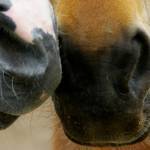The Horse’s Mouth: Understanding the Soft Palate

Unlike humans and certain other mammals, horses cannot breathe through their mouths under normal conditions. Animals with the physiological need to breathe nasally, rather than through the mouth or a combination of both, are known as obligate nasal breathers. An anatomical structure called the soft palate contributes to the horse’s inability to mouth-breathe.
Simply described, the soft palate is a musculomucosal sheet that separates the pharynx into oral and nasal compartments. In an average horse, the soft palate is about six inches (15 cm) long when measured medially and less than an inch thick (>2 cm). The rearmost portion of the soft palate fits snugly around the base of the epiglottis, and the soft palate remains fixed in this position at all times except when swallowing.
As the horse prepares to swallow, structures in the rear of the mouth shift. The tongue rises, positioning feed, forage, or water against the hard palate, which is situated on the roof of the mouth. The root of the tongue retracts, the opening of the larynx constricts, and the epiglottis seals the laryngeal opening. The soft palate elevates to the pharynx, and pressure sends ingesta into the esophagus, where wave-like contractions move it toward the stomach. This process, which happens innumerable times each day, prevents horses from inhaling food, but also precludes the use of the mouth in respiration. Because of this, horses cannot pant as a way of thermoregulation, as dogs do.
Few disorders of the soft palate have been recognized, though one causes much consternation for owners and trainers of horses involved in high-speed sports. Veterinarians often diagnose intermittent or persistent malpositioning of the soft palate dorsal to the epiglottis, called dorsal displacement of the soft palate (DDSP) or palate instability.








